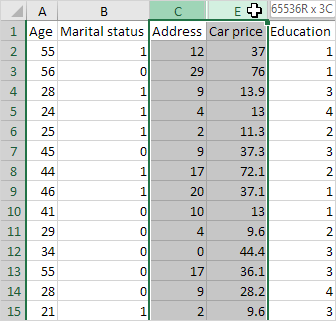Conditional formatting is a powerful tool in Excel that allows you to highlight cells based on their values. This can be used to quickly identify trends, outliers, and other important data points in your spreadsheets.
There are many different types of conditional formatting available in Excel, including:
- Highlight cells rules: These rules allow you to highlight cells based on their values, such as whether they are greater than or equal to a certain value, or contain a specific text string.
- Data bars: These rules add colored bars to cells to indicate their relative values.
- Color scales: These rules use a gradient of colors to indicate the values of cells.
- Icon sets: These rules add icons to cells to indicate their values.
Conditional formatting in Excel enables you to highlight cells with a certain color, depending on the cell’s value.
Highlight Cells Rules
To highlight cells that are greater than a value, execute the following steps.
1. Select the range A1:A10.

2. On the Home tab, in the Styles group, click Conditional Formatting.

3. Click Highlight Cells Rules, Greater Than.

4. Enter the value 80 and select a formatting style.

5. Click OK.
Result. Excel highlights the cells that are greater than 80.

6. Change the value of cell A1 to 81.
Result. Excel changes the format of cell A1 automatically.

Note: you can also use this category (see step 3) to highlight cells that are less than a value, between two values, equal to a value, cells that contain specific text, dates (today, last week, next month, etc.), duplicates or unique values.
Clear Rules
To clear a conditional formatting rule, execute the following steps.
1. Select the range A1:A10.

2. On the Home tab, in the Styles group, click Conditional Formatting.

3. Click Clear Rules, Clear Rules from Selected Cells.

Top/Bottom Rules
To highlight cells that are above average, execute the following steps.
1. Select the range A1:A10.

2. On the Home tab, in the Styles group, click Conditional Formatting.

3. Click Top/Bottom Rules, Above Average.

4. Select a formatting style.

5. Click OK.
Result. Excel calculates the average (42.5) and formats the cells that are above this average.

Note: you can also use this category (see step 3) to highlight the top n items, the top n percent, the bottom n items, the bottom n percent or cells that are below average.
Conditional Formatting with Formulas
Take your Excel skills to the next level and use a formula to determine which cells to format. Formulas that apply conditional formatting must evaluate to TRUE or FALSE.
1. Select the range A1:E5.

2. On the Home tab, in the Styles group, click Conditional Formatting.

3. Click New Rule.

4. Select ‘Use a formula to determine which cells to format‘.
5. Enter the formula =ISODD(A1)
6. Select a formatting style and click OK.

Result. Excel highlights all odd numbers.

Explanation: always write the formula for the upper-left cell in the selected range. Excel automatically copies the formula to the other cells. Thus, cell A2 contains the formula =ISODD(A2), cell A3 contains the formula =ISODD(A3), etc.
Here’s another example.
7. Select the range A2:D7.

8. Repeat steps 2-4 above.
9. Enter the formula =$C2=”USA”
10. Select a formatting style and click OK.

Result. Excel highlights all USA orders.

Explanation: we fixed the reference to column C by placing a $ symbol in front of the column letter ($C2). As a result, cell B2, C2 and cell D2 also contain the formula =$C2=”USA”, cell A3, B3, C3 and D3 contain the formula =$C3=”USA”, etc.
Additional Tips
Here are some additional tips for using conditional formatting:
- Use different types of conditional formatting to highlight different types of data. For example, you could use data bars to highlight the values of cells, and icon sets to highlight the status of cells.
- This feature is used to create visual alerts. For example, you could highlight cells that are over a certain value in red, to warn you that they are outside of the normal range.
- Use conditional formatting to create custom reports. For example, you could create a report that highlights all cells that are greater than a certain value, and then export the report to PDF.
| Next Chapter: Charts |